The Minnesota Women Behind Suffrage Were Ahead of Their Time
How anti-sexism pushed the suffrage movement forward.

Anti-sexist: What does this term even mean? To be anti-sexist, a person must blatantly and publicly disobey the rules put in place meant to oppress all genders. Sexism has been prevalent throughout history, including the history of Minnesota. The sexist laws and beliefs in Minnesota and the entire country kept women from gaining the right to vote, but were met with rebellion and tenacity from many outstanding women in Minnesota. Two of perhaps the most anti-sexist leaders were Dr. Martha Ripley and Julia Bullard Nelson. These Minnesota women accomplished amazing feats in their lifetimes by being actively anti-sexist in a time when accepting the status quo was a lot easier and more popular.
The 19th Century in the U.S. brought many obstacles for women. Women were not allowed to vote in any elections, participate in politics, or have rights to themselves, property, their children or any earned wages. Men and women had “separate spheres” in society. The men's “sphere” included working and politics, while the women’s “sphere” included maintaining the house and caring for the family. Another popular belief was that women were too delicate and simpleminded to participate in public life. Therefore, women did not have access to higher education or safe, high quality jobs. So, with all these barriers, how did women ever achieve the right to vote? Active anti-sexism was crucial for the women's suffrage movement.
A perfect example of being actively anti-sexist can be found in Dr. Martha Ripley, who was an advocate for women's rights all her life. She became educated well beyond what was typical for women of her time and, in 1886, even opened her own hospital in Minneapolis. At Ripley’s hospital, she did not deny unwed mothers health care as many other facilities did during this time. She also gave women, unwed mothers and their children housing, training and job resources, an act seen as highly controversial. She was one of the founders and presidents of the Minnesota Woman Suffrage Association (MWSA) from 1883 until 1889. She advocated for better working conditions and having more women publicly represented in society, such as the police force.
Another anti-sexist Minnesota woman is Julia Nelson Bullard, who worked alongside Ripley in the fight for suffrage. Nelson was an educator who traveled to the South to teach freed African Americans after the Civil War. She was threatened and ridiculed by many who thought her actions were dishonorable and egregious. Even with the fear of being attacked and ostracized, this Minnesota woman wasn’t just anti-sexist but also anti-racist. Nelson became a great orator who was paid for her speeches. Nelson, along with Ripley and a few others, founded the MWSA, and Nelson served as president from 1890 to 1896.
These two Minnesota women stood up for women’s rights during their entire lives. Dr. Martha Ripley and Julia Bullard Nelson bravely defied the laws and societal expectations that sought to diminish their talents and strengths. These women suffragists were actively anti-sexist in reaching their goals and, without their efforts, suffrage would not have come when it did to Minnesota in 1919.
Sexism still exists today, and the only way to combat sexism's injustices is to follow in the footsteps of Ripley and Nelson by being actively anti-sexist. The fight for equality is not over, and these one-of-a-kind Minnesota women would want Minnesotans to continue the fight. Think of the brave ways in which you can disobey blatantly and publicly the rules put in place that are meant to oppress all genders and contribute to the legacy of great Minnesota suffragist leaders.
Watch the Minnesota Experience documentary, Citizen, which explores the multigenerational march of Minnesota women and all they hoped would come with the vote.
Editor’s note: This story – and others in the collection, Then & Now: Reflections on Women’s Suffrage – was written by a St. Catherine University student in the Public Relations Writing class held in the spring of 2020. The piece has been minimally edited to preserve the integrity of the student’s perspective. We hope you enjoy discovering what the next generation of writers, historians and activists has to say about the impact of the women’s suffrage movement then and now.

This story is made possible by the Arts and Cultural Heritage Fund and the citizens of Minnesota.
As Minnesotans look for ways to show their support for healthcare workers on the front lines of the COVID-19 pandemic, we took a look back in time to celebrate the contributions that four women – all named Ruth – made to the state’s public health system.
Just 39 words in length, the 19th Amendment to the U.S. Constitution gave women the right to vote when it was passed on June 4, 1919 and enacted on August 26, 1920 – but its passage was fraught with decades of legal challenges and intense demonstrations in which women activists sometimes put their lives directly on the knife’s edge. Explore a timeline contributions of Minnesota women to the passage of the 19th Amendment.
